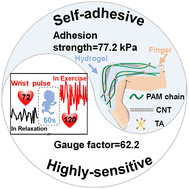Anisotropic hydrogels with high-sensitivity and self-adhesion for wearable sensors†
Abstract
Conductive hydrogels (CHs) are widely applied in soft electronic devices. However, the existing CHs excluded self-adhesion and high sensitivity at lower strains, hardly fulfilling the increasing requirements for the next-generation sensors. Inspired by the structure of muscle, an anisotropic hydrogel was designed to address this issue. The gel was prepared from acrylamide (AM), carbon nanotubes (CNTs), and tannic acid (TA), serving as the monomer, conductive filler, and tackifier, respectively. Next, a combination of pre-stretching, air-drying in a confining geometry, and immersion in an aqueous TA solution was adopted to induce the orientation structure. The mechanical strength of the hydrogel along the parallel stretching direction (75.2 kPa) was higher than that along the orthogonal stretching direction (22.2 kPa). Furthermore, the hydrogel showed anisotropic conductivity on account of regular conductive channels. The gauge factor (GF) parallel to the stretching direction was higher than that orthogonal to the stretching direction. The presence of CNTs and ordered structures endowed fast detection (response time of 200 ms) and high sensitivity (GF was 62.2 above 120% strain). In addition, the free catechol groups from TA empowered excellent self-adhesion (adhesion strength = 77.2 kPa). This work provided the basis for the manufacture of high-performance sensors, holding broad potential in flexible sensors, electronic skins, and soft robots.



 Please wait while we load your content...
Please wait while we load your content...